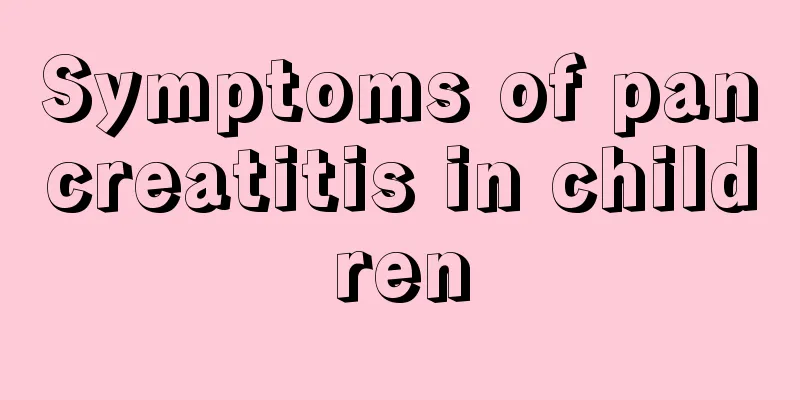Symptoms of pancreatitis in children

|
As our times become better and better, the food we eat has gradually become more diverse. It is precisely because we eat and drink too much that we develop some diseases, such as pancreatitis, but children may also get it. Some mothers may not understand why their children get this disease when they don’t eat or drink too much or drink alcohol. Pancreatitis is not necessarily caused by drinking, there may even be other reasons. Remember, you must not let your baby overeat, eat too much meat, and also do not eat too much greasy food. Although the pancreas is small, it plays an extraordinary role. The pancreatic juice secreted by the pancreas contains a large amount of digestive enzymes, which play a leading role in the food digestion process. Its main function is to neutralize stomach acid and digest sugar, protein and fat. Common symptoms of acute pancreatitis in children: Acute abdomen, upper abdominal pain, bloating, nausea, edema, bluish-purple spots around the umbilicus, inflammation 1. Symptoms It mostly occurs in children over 4 years old, and often presents with acute onset and acute appearance. 1. Abdominal signs (1) Abdominal pain and bloating: It is usually sudden and severe abdominal pain in the upper abdomen and around the navel, which then quickly spreads to the entire abdomen. The abdominal pain is persistent or worsens in intermittent bursts within 24 to 48 hours. Abdominal pain that worsens after eating. Children with abdominal pain may toss and turn restlessly, or even bend forward or sit or lie down with legs bent due to severe pain. They rarely complain of back pain or waist pain. Abdominal distension and peritoneal irritation signs are common in the early stages, which may lead to misdiagnosis of intestinal obstruction. (2) Tenderness: Mainly manifested in the upper abdomen or the entire abdomen. Upper left side of abdomen: mostly in the early stage or when the condition is mild. Upper right abdomen: pancreatic head lesions Upper abdomen: pancreatic body lesions Left upper abdomen: pancreatic body and tail lesions General abdominal tenderness: when there is exudate in the abdominal cavity In addition, children with pancreatitis may also experience tenderness in the lower back or percussion pain. (3) Diarrhea: mainly excreting large amounts of undigested food. reason: ① Pancreatic juice cannot enter the duodenum, causing digestive dysfunction. ② In severe cases, there is a large amount of enzymatic exudate in the abdominal cavity, which stimulates the gastrointestinal tract and causes gastrointestinal dysfunction. (4) Peritoneal irritation signs: Cause: Mainly due to bloody exudate containing pancreatic enzymes irritating the peritoneum. Its severity and the degree of abdominal muscle tension are basically consistent with the severity of the lesion. In patients with edematous pancreatitis, the peritoneal exudate is less or less obvious, and there are generally no peritoneal irritation signs. If the amount of peritoneal exudate is not large, or the exudate accumulates only in the lesser omental sac, peritoneal irritation signs may only appear in the upper abdomen. (5) Mobile Dullness: Cause: When the condition is serious, it causes widespread fluid accumulation in the abdominal cavity and increased intra-abdominal exudate. (6) Intestinal motility weakens or disappears: Symptoms: In the early stage, bowel sounds are often weakened, and in severe cases, bowel sounds disappear. reason: ① Pancreatic inflammation stimulates the celiac nerves, indirectly affecting intestinal peristalsis ② Direct stimulation of the intestinal tract by a large amount of exudate in the abdominal cavity. (7) Skin nodules and ecchymoses: ①Skin ecchymosis: Cause: Overflowing pancreatic juice penetrates the abdominal and waist muscles, breaks down subcutaneous fat, and causes capillary bleeding. Cullen's sign: bluish ecchymosis of the skin around the umbilicus Grey Turner's sign: Blood or activated proteases pass through the peritoneum, fascia, and muscles into the subcutaneous tissue, resulting in blue-green-brown ecchymosis on both sides of the abdomen or on the left side of the waist. It appears later and is characteristic of necrotizing pancreatitis. In addition, the skin of the limbs may also be damaged, presenting as purple spots, blisters, and necrosis, which is one of the signs of a serious condition. ②Subcutaneous nodular erythema: Distributed on the limbs, back, and buttocks, with a diameter of about 2 cm. It occurs late in the disease and is characteristic of acute hemorrhagic necrotizing pancreatitis. Cause: Fat necrosis and calcification. (8) Fullness or mass in the upper abdomen: Cause: Inflammatory reaction of upper abdominal organs, effusion of lesser omental sac and dilatation of transverse colon etc. 2. Clinical manifestations of extrapancreatic organ damage (2) Nausea and vomiting: Nausea and vomiting occur to varying degrees. The occurrences were more frequent in the beginning and the patient needed to be sent to the hospital for intravenous treatment, but they gradually decreased. Vomitus is often food and bile, gastric and duodenal secretions. Abdominal pain cannot be relieved after vomiting, and eating will also aggravate vomiting. (3) Fever: The body temperature may rise in the early stage, but when there is no secondary infection, the body temperature is generally around 38.5℃. (4) Gastrointestinal bleeding: ① In severe cases, vomiting of blood or bloody stool may occur. ② Erosive gastritis: When accompanied by hypoxemia, it can weaken the gastric mucosal barrier and cause gastric mucosal erosion and bleeding. (5) Pancreatic encephalopathy: Manifestations include mental abnormalities, irritability, drowsiness, delirium, and incoherent speech. In severe cases, there may be coma and unconsciousness. (6) Jaundice: Rare in children. Cause: Edema of the pancreatic head compresses the end of the common bile duct. If it is not due to biliary obstruction, it may be caused by toxic damage to the liver. Yellowing of the conjunctiva of both eyes or the skin of the whole body may occur. (7) Circulatory system: Heart failure may occur, mainly manifested by arrhythmia, sinus tachycardia or cardiogenic shock. (8) Respiratory system: Difficulty breathing, increased frequency, and in severe cases, cyanosis of the mucous membranes and nail beds. (9) Renal impairment: Oliguria or anuria occurs when fluid replacement is adequate. (10) Others: Extensive subcutaneous hemorrhages or flaky ecchymoses, especially at superficial injection needle puncture sites, or compression sites of the limbs (such as the compression site of the blood pressure cuff when measuring blood pressure) or gastrointestinal bleeding, may be DIC. |
<<: Symptoms of parasites in children
>>: Why do babies like to touch their ears?
Recommend
What to do if your child has a cough
Children may cough due to choking. Cough is one o...
What to do if your eyelids are puffy in the morning
Swollen eyelids in the morning is a common sympto...
The reason why 10-year-old children grind their teeth when sleeping
10-year-old children are in the period of growth,...
What should I do if my child has a serious food preference?
It is a common phenomenon that children have pick...
Causes of coffee spots in babies
Many people do not think that coffee spots are a ...
Is it a sign of brain hypoxia if the baby keeps straining?
Having a baby will make many parents feel very ha...
What tests will be done on newborn babies?
Many people don’t know that it is necessary to ch...
Newborn baby crying without tears
Since newborns do not have the ability to speak o...
What should I do if my child has pharyngitis and cough?
Pharyngitis is a common disease. When people talk...
Newborn baby's lips are blistered_What medicine should be used for children's lips blisters
Parents found a layer of blisters around their ba...
Baby's nose is blocked and breathing is difficult
When the child is young, the mother wants to keep...
What are the symptoms of paronychia in children?
It is not actually terrible for children to suffe...
Can babies eat eggs when they have a cold? Just pay attention to the relevant matters
If your baby is young, it is best not to eat eggs...
What is the cause of the white spot on the child's head?
The head is a very critical part. If white spots ...
Six-year-old girl's underwear is always yellow
Women's underwear is closely connected to the...









